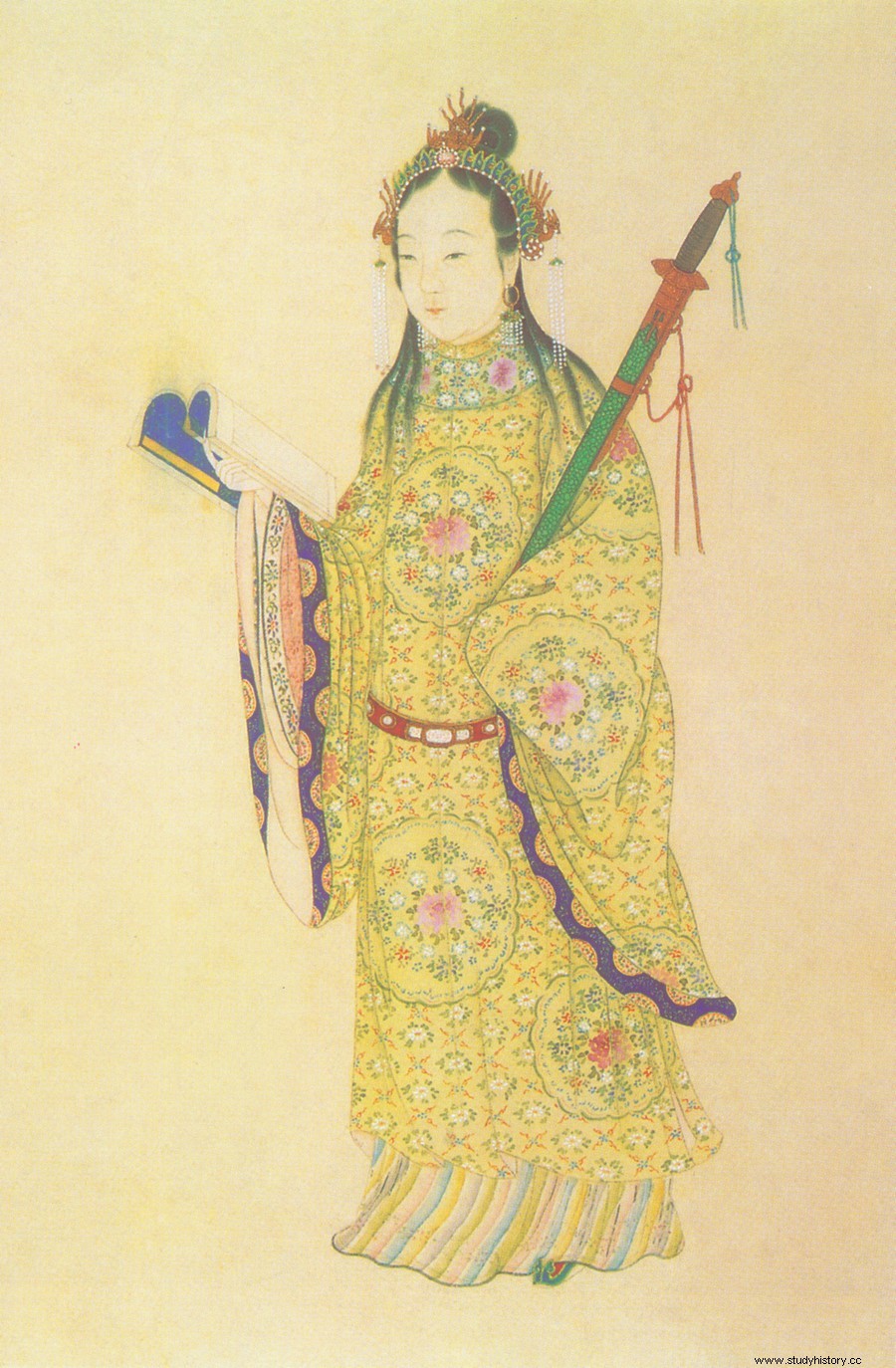Chinese general, Qin Liangyu or Zhensu (1574–1648) distinguished herself by defending the Ming dynasty against the attacks of the future Qing dynasty in the 17 e century.
An atypical education
Coming from a Miao family, Qin Liangyu was born in 1574 in Zhongzhou, in central China. The Ming dynasty, the last Chinese dynasty dominated by the Han, then reigns over the empire, and has done so since 1368. The eleven-year-old Emperor Wanli acceded to the throne two years earlier after the death of his father. At the time, the pirate attacks on the coast subsided and peace was concluded with the Mongols, but financial difficulties began for the Ming dynasty.

Going against the grain of his time, Liangyu's father, Qin Kui, believed that girls should receive the same education as boys. Like his brothers, Liangyu studied history, the works of Confucius, poetry. She trains in martial arts and is noted for her skills in archery and horseback riding.
Ma Qiancheng's wife
In 1595, aged 21, Qin Liangyu married Ma Qiancheng, the tusi (leader) and xuanfushi ("peace commissioner", a senior military official monitoring the border) of Shizhu County. The marriage seems harmonious; Ma Qiancheng often seeks advice from his wife, who accompanies him to the battlefield in clashes against warlords on the southwestern frontier of the Ming Empire.
The financial difficulties of the Ming dynasty worsen; to remedy this, the central power increased taxes on trade and agriculture, triggering a major wave of discontent and several episodes of revolts. In 1599, an insurrection broke out in Bozhou, to the south; Ma Qiancheng leads 3,000 cavalry into battle, while Liangyu accompanies him, leading an additional 500 men. Together they put an end to the revolt.
In 1613, Ma Qiancheng was arrested for angering a powerful and influential court eunuch. Imprisoned, he died in captivity and Liangyu succeeded him as xuanfushi from Shizhu County. The troops under his command are known as the "White Cavalry".
Fighting uprisings
In 1620, Emperor Wanli died and his son Taichang succeeded him; he reigned less than a month, before dying suddenly at age 38, possibly from poisoning. His own son, Tianqi, aged 15 and unfit to rule, took the throne in his turn. During the reign of this puppet emperor, the revolts continued. As early as 1618, the Manchu Nurhachi unified Jurchen tribes and revolted against the Ming dynasty. Gradually, he extended his territory and conquered cities in the province of Liaodong, in northern China. In 1620, Qin Banping, older brother of Qin Liangyu, died in battle fighting against the troops of Nurhachi.
To finance the war effort, the imperial power again heavily increases taxes, triggering new insurgencies. In 1623, Liangyu helped the Ming dynasty suppress the She-An rebellion in Sichuan and Guizhou. The following year, his older brother Qin Minping died in turn, during battles against the insurgents. The revolt lasted eight years, before being finally put down in the summer of 1629. By then, Emperor Tianqi had been dead for two years and his 16-year-old brother succeeded him. Striving to redress the catastrophic situation left by his predecessor, Chongzhen has to face a severe episode of drought and famine.
Guardian of the Ming Dynasty
In 1630, Nurhachi's son and successor Huang Taiji approached the Ming capital, Beijing. Qian Liangyu leads troops into battle and recaptures several cities, reducing the threat to Beijing. Impressed by the warlord's courage and skill, the Chongzhen Emperor dedicated four poems of praise to her. When she enters Beijing, her reputation and that of her troops are such that a crowd gathers around her to see her. The white cavalry is well trained; beyond their combat skills, its soldiers are disciplined and do not loot or mistreat people after their victories.
In 1634, the armies of Zhang Xianzhong, leader of a popular revolt, invaded Sichuan; Liangyu and his son, Ma Xianglin, lead their troops into battle and defeat the rebels. In 1640, she repressed a new insurrection, led by Luo Rucai. His efforts to defend the Ming dynasty were not enough, however:in 1644, the peasant revolt led by Li Zicheng entered Beijing and the Chongzhen Emperor committed suicide before being caught.
The end of the Ming dynasty
Li Zicheng proclaims himself emperor, but he is quickly overthrown by the Manchus who will become the Qing dynasty. Qin Liangyu strives to continue defending the Southern Ming, who are still resisting the Qing dynasty. As a reward for her loyal service, the ruler of the Southern Ming, Emperor Longwu, granted Liangyu a title of nobility, as well as the titles of Guardian of the Crown Prince and Minister General of Defense.
Qin Liangyu controls part of the Shizhu region, in which she cultivates the land to be self-sufficient and feed the refugees. Leading her territory to stability, she allowed around 100,000 refugees to settle in Shizhu. She died in 1648, aged 73 or 74.
